Languages of Tanzania
| Languages of Tanzania | |
|---|---|
 | |
| Official | Swahili[1] and English (de facto) |
| Regional | Arabic (in Zanzibar), Chaga, Makonde, Sukama, Nyiramba, Datooga |
| Minority | Many Bantu, Cushitic and Nilotic languages; Hadza, Sandawe, Omaio |
| Signed | Tanzanian sign languages |
| Keyboard layout | |

Tanzania is a multilingual country. There are many languages spoken in the country, none of which is spoken natively by a majority or a large plurality of the population. Swahili and English, the latter of which was inherited from colonial rule (see Tanganyika Territory), are widely spoken as lingua francas. They serve as working languages in the country, with Swahili being the official national language.[1] There are more speakers of Swahili than of English in Tanzania.[2]
Overview
[edit]
According to Ethnologue, there are a total of 126 languages spoken in Tanzania. Two are institutional, 18 are developing, 58 are vigorous, 40 are endangered, and 8 are dying. There are also three languages that recently became extinct.[2]
Most languages spoken locally belong to two broad language families: Niger-Congo (Bantu branch) and Nilo-Saharan (Nilotic branch), spoken by the country's Bantu and Nilotic populations, respectively. Additionally, the Hadza and Sandawe hunter-gatherers speak languages with click consonants, which have tentatively been classified within the Khoisan phylum (although Hadza may be a language isolate). The Cushitic and Semitic ethnic minorities speak languages belonging to the separate Afro-Asiatic family, with the Hindustani and British residents speaking languages from the Indo-European family.[3]
Tanzania's various ethnic groups typically speak their mother tongues within their own communities. The two official languages, Swahili and English, are used in varying degrees of fluency for communication with other populations. According to the official national linguistic policy announced in 1984, Swahili is the language of the social and political sphere as well as primary and adult education, whereas English is the language of secondary education, universities, technology, and higher courts.[4] The government announced in 2015 that it would discontinue the use of English as a language of education as part of an overhaul of the Tanzanian schools' system.[5]
Additionally, several Tanzanian sign languages are used.
Language families
[edit]Major languages
[edit]
Major languages spoken in Tanzania include:
- Niger-Congo
- Bantu
- Bemba
- Bena (592 thousand, 2009)
- Chaga
- Digo (166 thousand, 2009)
- Gogo (1.08 million, 2009)
- Haya (1.94 million, 2016)
- Hehe (1.21 million, 2016)
- Iramba
- Luguru (404 thousand, 2009)
- Makonde (1.47 million, 2016)
- Ngoni
- Nyakyusa
- Nyamwezi (1.47 million, 2016)
- Nyika
- Nyiramba
- Pare
- Rangi (410 thousand, 2007)
- Safwa (322 thousand, 2009)
- Sonjo
- Sukuma (8.13 million, 2016)
- Swahili
- Tongwe language
- Tumbuka (400 thousand, 2007)
- Turu
- Vidunda language
- Yao (630 thousand, 2016)
- Zanaki
- Kerewe
- Nyambo
- Gweno
- West Kilimanjaro (Meru)
- Bantu
- Nilo-Saharan
- Nilotic
- Datooga
- Kisankasa
- Maasai (682 thousand, 2016)
- Ngasa
- Ogiek
- Luo (185 thousand, 2009)
- Zinza language
- Sambaa language (660 thousand (2001))
- Nilotic
Minor languages
[edit]Languages spoken by the country's ethnic minorities include:

- Khoisan
- Khoe
- Hadza (possibly a language isolate)
- Sandawe (possibly a language isolate)
- Khoe
- Afro-Asiatic
- Indo-European
Extinct languages
[edit]See also
[edit]References
[edit]- ^ a b "Tanzania Profile". Tanzania Gov. Tanzanian Government. Archived from the original on 2 August 2017. Retrieved 23 July 2017.
- ^ a b "Tanzania". Ethnologue. Retrieved 12 June 2014.
- ^ "Languages of Tanzania". Ethnologue. Retrieved 12 June 2014.
- ^ J. A. Masebo & N. Nyangwine: Nadharia ya lugha Kiswahili 1. S. 126, ISBN 978-9987-676-09-5
- ^ "Tanzania Ditches English In Education Overhaul Plan". AFK Insider. 17 February 2015. Retrieved 23 February 2015.
Further reading
[edit]- Nurse, D. and Philippson, G. (2019). CLDF dataset derived from Nurse and Philippson's "Tanzania Language Survey" from 1975 (Version v3.0) [Data set]. Zenodo. doi:10.5281/zenodo.3535171
External links
[edit]- Languages of Tanzania at Ethnologue site.
- Map of languages of Tanzania at Ethnologue


